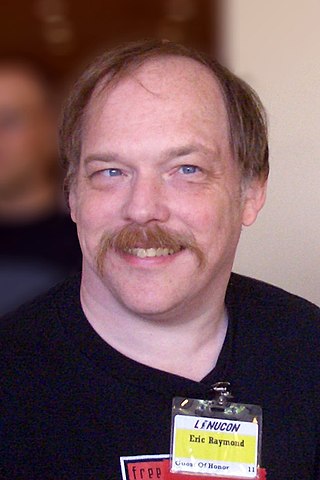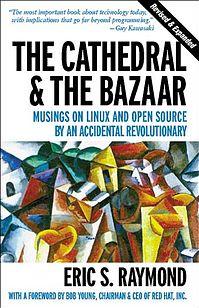
Bugzilla is a web-based general-purpose bug tracking system and testing tool originally developed and used by the Mozilla project, and licensed under the Mozilla Public License.

Eric Steven Raymond, often referred to as ESR, is an American software developer, open-source software advocate, and author of the 1997 essay and 1999 book The Cathedral and the Bazaar. He wrote a guidebook for the Roguelike game NetHack. In the 1990s, he edited and updated the Jargon File, published as The New Hacker's Dictionary.

Open-source licenses are software licenses that allow content to be used, modified, and shared. They facilitate free and open-source software (FOSS) development. Intellectual property (IP) laws restrict the modification and sharing of creative works. Free and open-source licenses use these existing legal structures for an inverse purpose. They grant the recipient the rights to use the software, examine the source code, modify it, and distribute the modifications. These criteria are outlined in the Open Source Definition.
Jamie Werner Zawinski, commonly known as jwz, is an American computer programmer, blogger and impresario. He is best known for his role in the creation of Netscape Navigator, Netscape Mail, Lucid Emacs, Mozilla.org, and XScreenSaver. He is also the proprietor of DNA Lounge, a nightclub and live music venue in San Francisco.
Gecko is a browser engine developed by Mozilla. It is used in the Firefox browser, the Thunderbird email client, and many other projects.
"Homesteading the Noosphere" is an essay written by Eric S. Raymond about the social workings of open-source software development. It follows his previous piece "The Cathedral and the Bazaar" (1997).
In software development, Linus's law is the assertion that "given enough eyeballs, all bugs are shallow". The law was formulated by Eric S. Raymond in his essay and book The Cathedral and the Bazaar (1999), and was named in honor of Linus Torvalds.

Revolution OS is a 2001 documentary film that traces the twenty-year history of GNU, Linux, open source, and the free software movement.

Open-source software (OSS) is computer software that is released under a license in which the copyright holder grants users the rights to use, study, change, and distribute the software and its source code to anyone and for any purpose. Open-source software may be developed in a collaborative, public manner. Open-source software is a prominent example of open collaboration, meaning any capable user is able to participate online in development, making the number of possible contributors indefinite. The ability to examine the code facilitates public trust in the software.
Multi-licensing is the practice of distributing software under two or more different sets of terms and conditions. This may mean multiple different software licenses or sets of licenses. Prefixes may be used to indicate the number of licenses used, e.g. dual-licensed for software licensed under two different licenses.
Open-source software development (OSSD) is the process by which open-source software, or similar software whose source code is publicly available, is developed by an open-source software project. These are software products available with its source code under an open-source license to study, change, and improve its design. Examples of some popular open-source software products are Mozilla Firefox, Google Chromium, Android, LibreOffice and the VLC media player.
Alternative terms for free software, such as open source, FOSS, and FLOSS, have been a controversial issue among free and open-source software users from the late 1990s onwards. These terms share almost identical licence criteria and development practices.

In the 1950s and 1960s, computer operating software and compilers were delivered as a part of hardware purchases without separate fees. At the time, source code, the human-readable form of software, was generally distributed with the software providing the ability to fix bugs or add new functions. Universities were early adopters of computing technology. Many of the modifications developed by universities were openly shared, in keeping with the academic principles of sharing knowledge, and organizations sprung up to facilitate sharing. As large-scale operating systems matured, fewer organizations allowed modifications to the operating software, and eventually such operating systems were closed to modification. However, utilities and other added-function applications are still shared and new organizations have been formed to promote the sharing of software.
Nikolai Bezroukov is a Senior Internet Security Analyst at BASF Corporation and was member of Computer Science at Fairleigh Dickinson University. Also Webmaster of Open Source Software University, a volunteer technical site for the United Nations Sustainable Development Networking Programme (SDNP) that helps with Internet connectivity and distributes Linux to developing countries.
License compatibility is a legal framework that allows for pieces of software with different software licenses to be distributed together. The need for such a framework arises because the different licenses can contain contradictory requirements, rendering it impossible to legally combine source code from separately-licensed software in order to create and publish a new program. Proprietary licenses are generally program-specific and incompatible; authors must negotiate to combine code. Copyleft licenses are commonly deliberately incompatible with proprietary licenses, in order to prevent copyleft software from being re-licensed under a proprietary license, turning it into proprietary software. Many copyleft licenses explicitly allow relicensing under some other copyleft licenses. Permissive licenses are compatible with everything, including proprietary licenses; there is thus no guarantee that all derived works will remain under a permissive license.
"The Magic Cauldron" is an essay by Eric S. Raymond on the open-source economic model. It can be read freely online and was published in his 1999 book, The Cathedral and the Bazaar.
Release early, release often is a software development philosophy that emphasizes the importance of early and frequent releases in creating a tight feedback loop between developers and testers or users, contrary to a feature-based release strategy. Advocates argue that this allows the software development to progress faster, enables the user to help define what the software will become, better conforms to the users' requirements for the software, and ultimately results in higher quality software. The development philosophy attempts to eliminate the risk of creating software that no one will use.
Mozilla is a free software community founded in 1998 by members of Netscape. The Mozilla community uses, develops, publishes and supports Mozilla products, thereby promoting exclusively free software and open standards, with only minor exceptions. The community is supported institutionally by the non-profit Mozilla Foundation and its tax-paying subsidiary, the Mozilla Corporation.
The Core Infrastructure Initiative (CII) was a project of the Linux Foundation to fund and support free and open-source software projects that are critical to the functioning of the Internet and other major information systems. The project was announced on 24 April 2014 in the wake of Heartbleed, a critical security bug in OpenSSL that is used on millions of websites.
Software relicensing is applied in open-source software development when software licenses of software modules are incompatible and are required to be compatible for a greater combined work. Licenses applied to software as copyrightable works, in source code as binary form, can contain contradictory clauses. These requirements can make it impossible to combine source code or content of several software works to create a new combined one.






